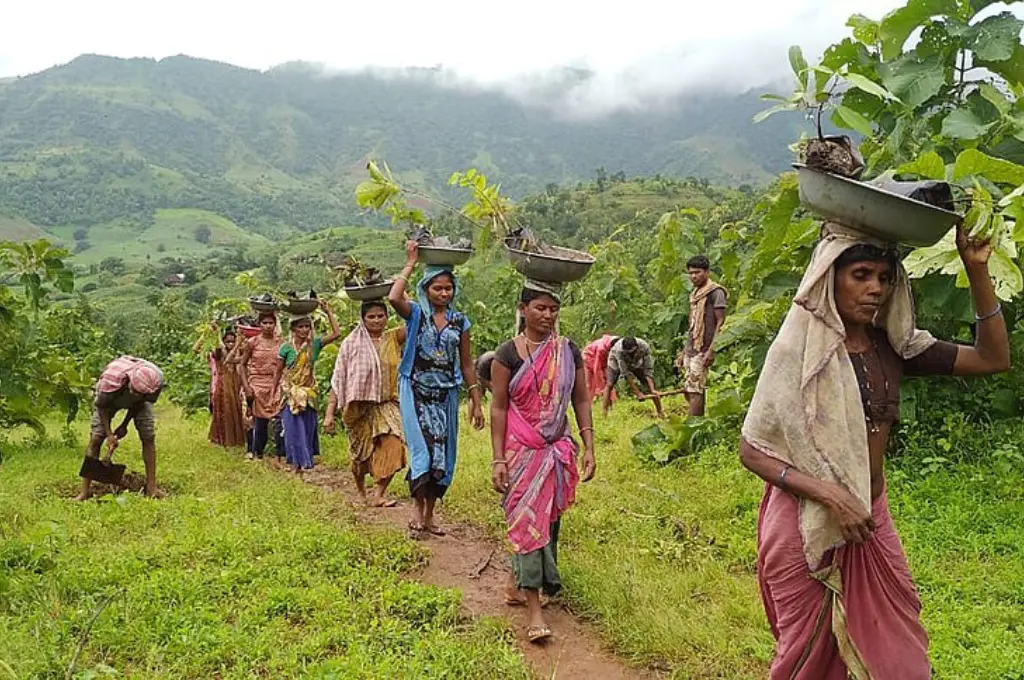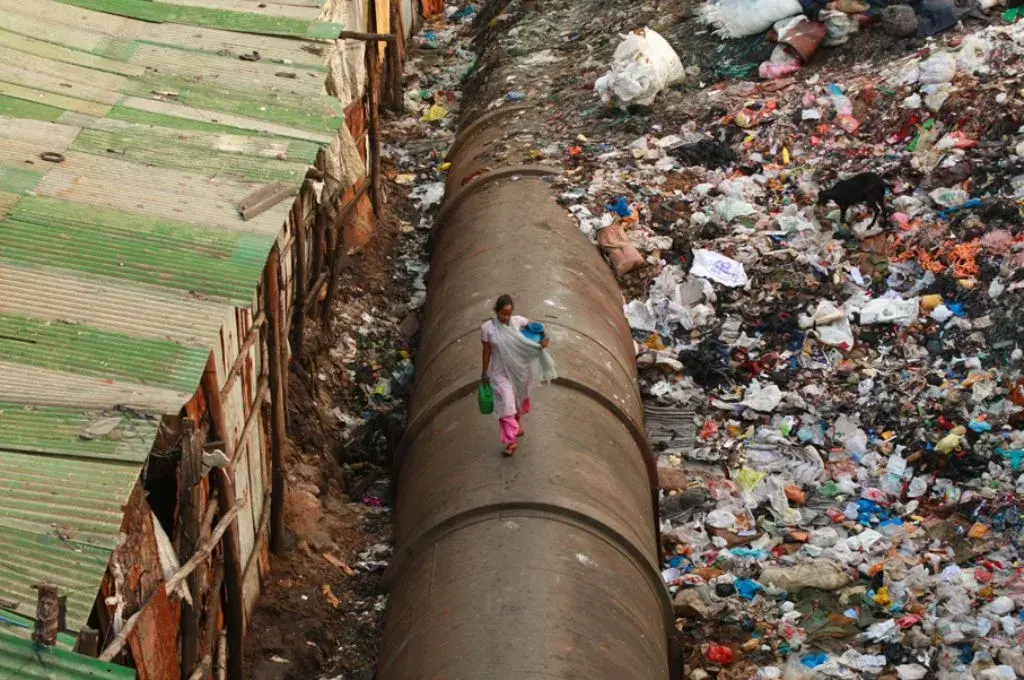A new umbrella scheme for forest-dwelling communities opens the doors for privatising the implementation of the Forest Rights Act (FRA). Passed in 2006, the FRA is a landmark law that recognises the land rights of forest-dwelling communities and empowers them to sustainably protect common forest resources—a practice deeply rooted in their culture for centuries. The FRA decentralises and democratises forest governance by giving autonomy to the gram sabha, a community-led body, to process individual and community claims over forest land.
Activists and researchers fear that the Centre is shifting control of the act from community-led bodies to external agencies and other government departments. The most recent attempt comes in the form of the Dharti Aaba Janjatiya Gram Utkarsh Abhiyan (DAJGUA) scheme, which was launched in October 2024 on the 150th birth anniversary of Adivasi freedom fighter Birsa Munda. DAJGUA converges schemes and programmes under 17 ministries for implementation in Adivasi districts where performance on socio-economic indicators is lower than the national average. Over five years, INR 79,156 crore will be spent to rectify deficiencies in infrastructure, healthcare, education, and livelihoods, among other areas.
As far as FRA-related initiatives are concerned, the following will fall under the new scheme:
- Digitisation of FRA documents and development of state-level and national-level FRA portals;
- Mapping of potential forest areas where FRA can be implemented;
- Setting up of FRA cells that will be manned by contractual staff in districts;
- Provision of support through private agencies for the implementation of community forest rights (CFR) management plans. CFR, a critical component of the FRA, grants rights to land and forest produce to forest-dwelling communities.
In an attempt to streamline and expedite the FRA claim verification process, DAJGUA introduces several layers of governance. According to activists, these extra layers turn the rights-based legislation to one akin to a welfare scheme, where the government and its appointed bodies make critical decisions for the people.
Who supports whom: Gram sabhas versus FRA cells
Currently, the FRA claims process is plagued by high rejection rates and slow processing of applications. Data from the Ministry of Tribal Affairs (MoTA) shows that, as of January 2025, 36 percent of the nearly 50 lakh claims have been rejected. FRA implementation too has problems—it is rife with delays and lack of proper processes to verify documents. Currently, 7.5 lakh applications remain pending, and while more than 2 lakh CFR applications were received, only around 1.17 lakh land pattas (titles) have been distributed so far to the communities.
Additionally, forest-dwellers are evicted from the land if their claims under the FRA are rejected, despite a Supreme Court stay on such evictions. Under the guise of addressing encroachment, the outdated Indian Forest Act is invoked to justify these actions.
Gram sabhas often lack the necessary support or guidance to develop forest management plans or effectively exercise their rights related to forest conservation and regeneration. Overall, the implementation of the FRA has been systematically weakened—either by bypassing due process or by undermining the authority of the gram sabha.

DAJGUA is being brought in to mitigate some of these challenges. But here’s how it can be at odds with the gram sabha’s functions:
1. Funding
DAJGUA will inject significant funding to MoTA to expedite FRA activities. Until now, gram sabhas have relied on gram panchayats—which are elected village bodies under the Panchayati Raj system—for receiving and disbursing funds. Therefore, although gram sabhas are somewhat financially empowered, DAJGUA allots significant funds to create new bodies populated by non-locals, that is, FRA cells at the district and state levels, which can run contrary to the aim of strengthening gram sabhas.
For instance, gram sabhas will be provided up to INR 15 lakh for implementing CFR management plans for 100 hectares of land. These plans improve forest-based livelihoods, protect forests and biodiversity, and ensure equitable distribution of forest benefits. However, gram sabhas are supposed to be trained to make their own management plans. If outside entities are brought in to make the plans, it will subvert the gram sabha’s authority. In fact, technical partners would get INR 1 lakh for assisting gram sabhas with preparing and executing a management plan.
The Centre will determine the amount given to each state to set up FRA cells, based on the number of districts. For instance, Odisha received INR 5.02 crore for 30 districts for a year, whereas Assam got INR 3.12 crore for 18 districts for two years. Overall, no state is funded with more than INR 10 crore. Still, this will in effect make FRA cells better funded than the gram sabhas.
2. Supervision
The role of FRA cells is all-encompassing. FRA cells will:
- collect, store, analyse, and utilise data on the FRA
- coordinate with the subdivisional level committee and divisional level committees, which are statutory bodies that review rejected FRA applications
- create capacity-building and public awareness programmes
- play a supervisory role and “ensure” land conversion processes are “completed smoothly in a time-bound manner by the Gram Sabha concerned”
Tushar Dash, an independent FRA researcher, elaborates, “FRA cells are a parallel structure. Instead of strengthening nodal agencies such as the state tribal welfare departments [to monitor high rejection rates and pending claims], the Centre is funding and involving private tech operators who will end up being part of FRA cells.”
The creation of these cells can also be interpreted as a violation of the FRA. A 2015 MoTA explainer on the FRA makes this clear: “[The Rules do not] permit constitution of a committee comprising persons other than the members of the gram sabha, for assisting the gram sabha in discharge of its functions relating to recognition and vesting of forest rights under the FRA. In fact, any decision/action taken by such a committee would be void and have no legal basis.”
According to some researchers, the FRA cells could provide bureaucratic support to tribal departments that are underfunded and understaffed. “I don’t think two or three people within an FRA cell can take over established processes,” says Sharachchandra Lele, distinguished fellow at the Centre for Environment and Development, ATREE, Bengaluru. However, Sharachchandra concedes that the scheme has its own drawbacks, “It has a short-term perspective. The scheme adds a bit of funding and pushes for target-based implementation, without strengthening legislated procedures to make it more sustainable and bottom-up in the long term.”
3. Urgency
DAJGUA sets about an urgency in the implementation of the FRA process. Funding from the Centre will be available for two years for critical activities such as settlement of individual and community rights under the FRA. Payments to external agencies, including FRA cells, will be linked to deliverables based on these two-year targets.
Time-bound targets have not worked for the FRA so far. In 2015, the central government attempted a ‘mission-mode’ approach, with a deadline of six months for nine states to settle the forest rights claims. This was done so that it would be quicker to divert forest land for other projects related to mining, infrastructure, and more. This move incentivised states to show targets on paper. For instance, in Chhattisgarh, the pressure to reach targets led to the government forcing gram sabhas to give certificates claiming that the implementation of the FRA had been completed. The realities on the ground were often different from what was being stated in these certificates. It violated the FRA process, which is participatory and requires multiple steps before filing and processing of a claim. This was repeated in several states where the provisions of the law were undercut to meet targets.
A process riddled with technological errors
FRA documents digitised by the FRA cells will be hosted on state-level portals developed using funding from DAJGUA. These portals will also have provisions for online processing of claims. However, the increasing role of non-forest-dwellers in this process raises concerns as pilots and experiments in the recent past have not been encouraging. DAJGUA doesn’t acknowledge or rectify these experiences.
Take, for instance, Madhya Pradesh’s VanMitra project, which employs private kiosk operators and an online portal to digitally process the review of FRA rejections. Applicants can appeal through the mobile app when an FRA claim is rejected. In 2019, before the launch of the project, the rejection rate was 61 percent. With the app, in 2021, this increased to 74 percent and, by June 2023, the rejection rate was at 78 percent.
Researchers noted that these private operators had little accountability due to a lack of stake in the issue. Applicants were largely finding the technology difficult to navigate, and operators often uploaded incorrect or incomplete information.
The FRA in itself also employs the use of satellite imagery and geographic information system (GIS) to capture, store, check, and display data for mapping potential CFR areas. This process generates baseline data to identify rightful FRA holders as well as the extent of forest land eligible for rights recognition, and helps prepare districtwise implementation plans.
The DAJGUA assigns GIS duty to Bhaskaracharya National Institute for Space Applications and Geo-informatics (BISAG-N), a government-run autonomous research institute. In 2010, the Gujarat government had verified FRA applications through satellite imagery gathered by the institute to determine if the applicant had cultivated or occupied the land in question in the years before the enactment of the FRA legislation. The process was found to be faulty and was eventually removed from the FRA settlement procedure. This has led to questions about BISAG-N being given this responsibility again.
Another point of concern is the selection of the national-level portal PM Gatishakti—a database created in 2021 for ongoing and future infrastructure projects undertaken by different ministries—to host FRA data. The portal’s data is now openly available to encourage private sectors to invest in industrial planning.
“Gatishakti will be a rich repository for the private sector. In areas where the titles have been distributed, the title-holders can be approached by private players to undertake activities such as plantation under carbon credit or organic farming businesses, which have been found to be exploitative,” says C R Bijoy, an FRA activist and researcher who was among the proponents of the law in the early 2000s. He sees DAJGUA as part of a larger trend of promoting ‘ease of doing business’—even in forests. The spirit of this approach is in conflict with the tenets of the FRA legislation.
Bringing back the forest department
For activists and FRA experts, the interventions under DAJGUA undoes the decades-long people’s movement that had led to the enactment of the act.
The legislation was created in response to a mass movement by indigenous communities who demanded the rectification of historical injustices that excluded them from forest governance. Communities were often considered encroachers by the forest department and state governments. The FRA replaces forest department officials as the sole custodians of forest land by including Adivasi populations and other forest-dwellers in the decision-making process. CFR is an example of this principle. Forest-dwelling communities, through gram sabhas, were given the sole responsibility of managing these forest areas and their produce.
DAJGUA could allow the back-door entry of the forest department through technical partners and civil society organisations.
Since 2023, MoTA has been diluting the role of gram sabhas in preparation of CFR plans. Surprisingly, as early as March 2024, MoTA and the Ministry of Environment, Forest, and Climate Change had issued a joint advisory that suggested involving forest officers in CFR management committees.
DAJGUA doubles down on these contentious decisions. According to FRA researchers, it could potentially allow for the back-door entry of the forest department through the engagement of an external agency, technical partner, or civil society organisations (CSOs) to aid in the preparation and implementation of CFR conservation and management plans. These external agencies will be paid INR 1 lakh. Tushar explains, “These plans will have to align with the National Working Plan Code (developed by the forest department to manage forests) and forest officials will be master trainers for external agencies. Power and funding of CFR management will shift to the forest department and private agencies.”
In the past, the inclusion of forest officials through joint forest management committees or village forest rules in decision-making have led to issues. In Madhya Pradesh, for example, these ‘forest committees’ levied a fee from villagers for consumption of forest resources, which is against CFR rules.
Currently, four states—Chhattisgarh, Madhya Pradesh, Maharashtra, and Odisha—account for approximately 80 percent of all CFR titles given. “The funding for CFR management under DAJGUA will only go to states where CFR titles have been recognised. Since these four states have distributed most CFR titles, they will be the only states benefitting from the DAJGUA funding. So, a few thousand villages will get CFR support, while lakhs of villages will be excluded,” says Dr Manohar Chauhan, an FRA expert associated with Foundation for Ecological Security (FES).
Despite the criticism, the scheme could be instrumental in recognising the rights of forest-dwelling communities if implemented thoughtfully. Allowing gram sabhas to select their own CSOs or technical partners can create trust-based relationships and acknowledge the long-standing contributions of grassroots nonprofits already working with these communities.
To speed up the claims process, funding should be prioritised in states where CFR titles remain largely unrecognised. While the digitisation of records is a valuable step towards transparency, it must be verified and approved by the gram sabhas. The funding can also be made flexible as per land area, biodiversity, and Adivasi population to ensure meaningful support for forest regeneration and rights enforcement.
—





